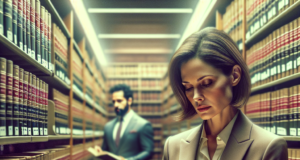Shocking Appeals Court Decisions: Unraveling Legal Precedents That Shocked the Nation

In the complex landscape of the American legal system, appeals courts play a pivotal role in shaping not only legal precedents but also public perception of justice. Their decisions often reverberate beyond the courtroom, influencing societal norms and legislative frameworks. This article delves into some of the most shocking appeals court decisions that have redefined legal boundaries, sparked national debate, and prompted significant public reaction, ultimately illustrating the profound impact these rulings have on the future of legal interpretations.
The Role of Appeals Courts in Shaping Legal Precedents and Public Perception
Appeals courts serve as critical arbiters in the judicial system, tasked with reviewing the decisions made by lower courts to ensure that legal standards are upheld and justice is served. Their rulings not only clarify existing laws but also set binding precedents that guide future cases. This role is particularly significant in a federal system where interpretations of law can vary widely across jurisdictions. As such, appeals courts often find themselves at the intersection of law and public sentiment, where their decisions can influence societal norms and expectations regarding justice and equity. The power of these courts to shape legal precedents is matched only by their ability to sway public perception, making their rulings a focal point for national discourse.
Landmark Cases: An Overview of Appeals Court Decisions That Redefined Legal Boundaries
Throughout history, several landmark cases have emerged from appeals courts, fundamentally altering the legal landscape of the United States. One such case is Brown v. Board of Education, where the Supreme Court’s ruling against racial segregation in public schools set a precedent that challenged systemic discrimination. Similarly, the Roe v. Wade decision established a woman’s right to choose, redefining reproductive rights and igniting ongoing debates about bodily autonomy. These cases exemplify how appeals courts can serve as catalysts for change, pushing the boundaries of legal interpretation and reflecting evolving societal values. The implications of these decisions extend far beyond the cases themselves, influencing legislation and public policy for generations.
Controversial Rulings: Examining Appeals Court Decisions That Stirred National Debate
Some appeals court decisions have sparked intense national debate, often polarizing public opinion and igniting discussions about fundamental rights and liberties. The Shelby County v. Holder ruling, which invalidated key provisions of the Voting Rights Act, is a prime example. Critics argued that the decision undermined decades of progress in protecting minority voting rights, while supporters claimed it restored state sovereignty. Similarly, the Citizens United v. FEC ruling, which allowed for unlimited corporate spending in elections, raised questions about the influence of money in politics and its implications for democratic processes. These controversial rulings not only challenge existing legal frameworks but also provoke widespread public discourse, highlighting the delicate balance between judicial interpretation and societal values.
The Impact of Shocking Appeals Court Decisions on Future Legal Interpretations
The ramifications of shocking appeals court decisions extend well beyond their immediate context, often setting the stage for future legal interpretations. Rulings that challenge established norms can lead to a reevaluation of existing laws and prompt legislative bodies to respond. For instance, the Obergefell v. Hodges decision, which legalized same-sex marriage nationwide, not only affirmed the rights of LGBTQ+ individuals but also influenced subsequent cases related to discrimination and civil rights. As appeals courts continue to navigate complex legal issues, their decisions will invariably shape the trajectory of legal interpretations, influencing how laws are applied and understood in a rapidly changing society.
Public Reaction: How Appeals Court Rulings Sparked Protests and Legislative Changes
The public’s response to appeals court rulings can be swift and powerful, often manifesting in protests, advocacy campaigns, and calls for legislative change. Following the Dobbs v. Jackson Women’s Health Organization decision, which overturned Roe v. Wade, widespread protests erupted across the nation, reflecting deep-seated concerns about reproductive rights and bodily autonomy. Similarly, the backlash against the Shelby County v. Holder ruling led to renewed efforts to restore protections for minority voters through legislative measures. These reactions underscore the profound connection between judicial decisions and public sentiment, illustrating how appeals court rulings can galvanize communities and prompt significant political action.
In conclusion, the shocking decisions rendered by appeals courts have far-reaching implications that extend beyond the legal realm, influencing public perception, societal norms, and legislative frameworks. As these courts continue to navigate complex legal landscapes, the lessons learned from landmark and controversial rulings will remain vital in shaping future interpretations of law. The interplay between judicial decisions and public reaction serves as a reminder of the dynamic nature of the legal system, where the pursuit of justice is often intertwined with the evolving values of society. As we reflect on these pivotal moments in legal history, it becomes clear that appeals courts will continue to play a crucial role in challenging the status quo and fostering meaningful change.







 Who is Bernard Madoff?
Who is Bernard Madoff? What is Trial Murder?
What is Trial Murder? The Background of Virginia v. Black (2003)
The Background of Virginia v. Black (2003) The Background of the West Memphis 3 Trial (1994)
The Background of the West Memphis 3 Trial (1994) The Background of Worcester v. Georgia (1832)
The Background of Worcester v. Georgia (1832)












